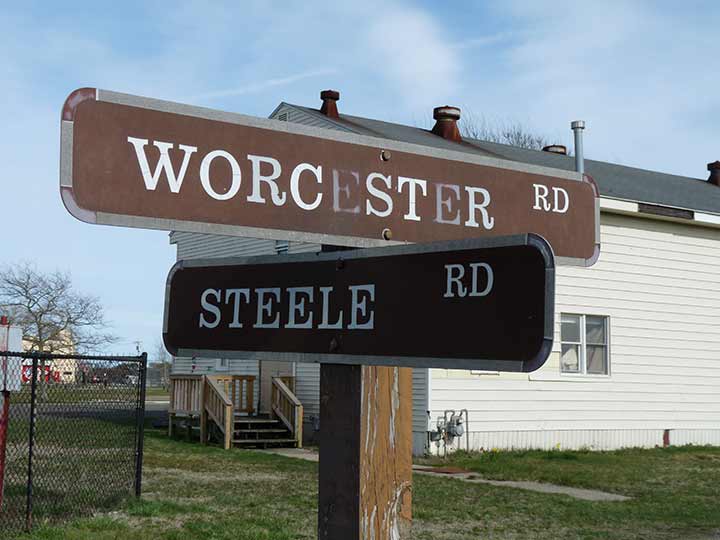
FORT Tilden, on the western edge of the Rockaway peninsula, was conceived when the USA entered World War I in 1917 as a coastal artillery protector with cannons as long-ranged as any battleship afloat at the time. It was designed to keep an attacking force far enough out at sea to prevent a bombardment of communication, manufacturing and shipbuilding facilities, all the while training National Guardsmen who would man these guns in times of emergency.
I recently found myself in Fort Tilden again after many years, after walking west from Beach 116th Street to catch the bus back to “The Junction” in Flatbush to pick up the #2 train back to Penn Station. I shot some scenes around the fort, but I was too tired at that point to do a true exploration encompassing the still-existing fortified batteries and armament magazines. It’s been nearly 15 years since I saw them…at least…so when the weather cools a bit I may make my way down there. I once had a Forgotten NY tour scheduled to visit Fort Tilden then cross the Gil Hodges Marine Park Bridge to visit FloydBennett Field; but a 98-degree day canceled the plan. In cooler conditions, a tour visited the airfield as well as Dead Horse Bay in 2018. I believe I have some leftover photos from that day I have yet to use.
Fort Tilden, like its cousins Fort Totten and Fort Schuyler and even Floyd Bennett Field, has its own named road layout that is independent from NYC’s street grid. And thus, it has its own street sign design. The overwhelming style in Fort Tilden seems to be brown and white, with street names set in Clarendon Bold. This really opens FNY up to new genre, nonstandard FNY street signs. I can visit Kennedy and LaGuardia Airports as well as Governors Island and the locales named above for samples.
Some parts of town are more reluctant to give up their secrets. Sea Gate uses standard Department of Transportation signage. I haven’t been in Breezy Point or Roxbury, but Sergey has. Even though Forts Schuyler, Totten and Tilden are mostly public parks now, there are still areas given over to the Coast Guard and/or FDNY, and I still holster the camera when uniformed personnel appear. The Brooklyn Navy Yard is a tougher nut to crack, even though it has a NYC Ferry stop. Those who debark are expected to go to Building 77, which has several eateries, and the public Building 92 (art installations) or the Walgreens. Otherwise, you are liable to be stopped if caught aiming a camera; the Navy Yard is full of private contractors, shipyards, studios and manufacturers who zealously guard secrets. I have contacted the BNY for codification of their photo policy but have been met with stony silence.
As always, “comment…as you see fit.” I earn a small payment when you click on any ad on the site. Take a look at the new JOBS link in the red toolbar at the top of the page on the desktop version, as I also get a small payment when you view a job via that link.


2 comments
The brown and white signs may be a National Park Service design. Fort Hancock in NJ has a similar color scheme (though a somewhat different design), as does the Delaware Water Gap National Recreation Area. So these signs may have been installed by NPS after the Military was out of Fort Tilden. Older pictures from when the Army was still there may answer that.
As I remember, street signs in Breezy Point are of the vertical post design, white four-sided posts about 4′ high with the names of streets engraved vertically on each side.
There is a development in East New York along Loring Avenue and Emerald, Amber and Sapphire Streets which used a suburban-type street sign, but they are gradually being replaced by DOT standard signs.
It may not just be in the Brooklyn Navy Yard in which studios zealously guard secrets. Some months ago I was checking out Bethpage Business Park, north of the LIRR tracks, to see if there were any visible rail remnants from the days when it was Grumman Aircraft’s shipping, receiving, and warehousing facilities. One of the several buildings on the site was a film studio, Gold Coast Studios, and to my bemusement it was surrounded by a high fence and security gate as if there was some top-secret stuff going on within. Even a nearby Northrop Grumman facility, where I’m sure there *is* secret stuff going on and you need a security clearance to work, was much less forbidding. I mean really, it’s just movie and TV stuff.
Note: even though it once had a network of sidings the only thing I could find in the business park was about a ten-foot stretch of heavily overgrown rail leading off the LIRR track.